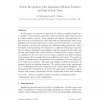Free Online Productivity Tools
i2Speak
i2Symbol
i2OCR
iTex2Img
iWeb2Print
iWeb2Shot
i2Type
iPdf2Split
iPdf2Merge
i2Bopomofo
i2Arabic
i2Style
i2Image
i2PDF
iLatex2Rtf
Sci2ools
108
click to vote
CVIU
2011
2011
Action recognition with appearance-motion features and fast search trees
In this paper we propose an approach for action recognition based on a vocabulary of local motion-appearance features and fast approximate search in a large number of trees. Large numbers of features with associated motion vectors are extracted from video data and are represented by many trees. Multiple interest point detectors are used to provide features for every frame. The motion vectors for the features are estimated using optical flow and a descriptor based matching. The features are combined with image segmentation to estimate dominant homographies, and then separated into static and moving ones despite the camera motion. Features from a query sequence are matched to the trees and vote for action categories and their locations. Large number of trees make the process efficient and robust. The system is capable of simultaneous categorisation and localisation of actions using only a few frames per sequence. The approach obtains excellent performance on standard action recognition...
| Added | 13 May 2011 |
| Updated | 13 May 2011 |
| Type | Journal |
| Year | 2011 |
| Where | CVIU |
| Authors | Krystian Mikolajczyk, Hirofumi Uemura |
Comments (0)

